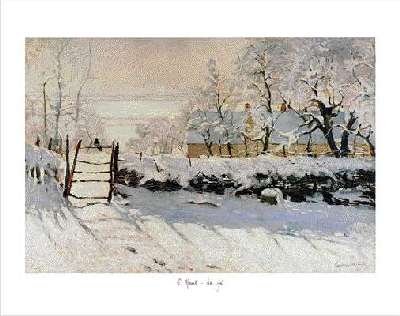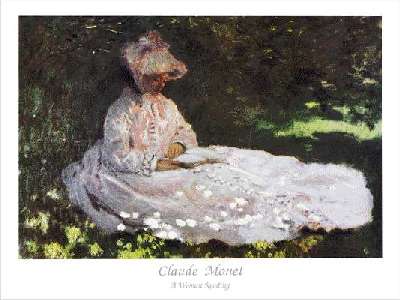Claude MONET fut un artiste professionnel : non seulement il n'a jamais eu d'autre source de revenus que la peinture mais il a interprété sa vie entière en peinture. Elève au collège du Havre il vend autour de lui des caricatures de ses professeurs et des notables de la ville. Puis du bonheur de la vie familiale au drame de la mort de sa femme Camille, tout devient sujet. Il semble qu'il lui est impossible d'exprimer autrement ses émotions que sous la forme d'une oeuvre d'art. Et quel Art !
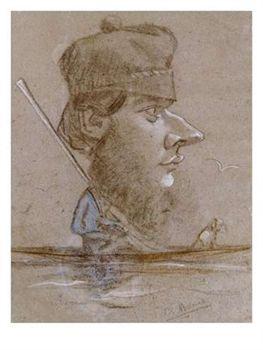
Le chasseur et son chien dans un bateau
A Hunter And His Dog On A Boat
Claude Oscar MONET circa 1858
Claude MONET was an artist by trade. He never earned money from anything but his paintings. He began at school selling caricatures of his teachers. All his feelings from happiness with his family to the painful death of his wife Camille turned into subjects for paintings. It seems that he didn't know how to express himself except on a canvas.
Monet réalise quelques natures mortes et les présente aux écoles d'Art à Paris pour y être reçu comme élève.
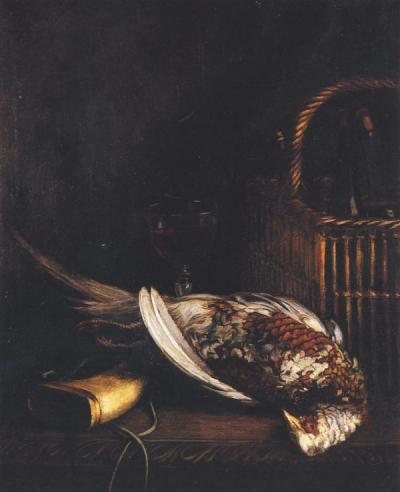
Nature
morte au faisan
Still
Life with Pheasant
Claude Oscar MONET 1861
Musée des Beaux Arts de Rouen, France
Monet painted then Still Lifes in order to show them to Art Schools in Paris and become Art Student.
Il aborde très vite (dès 1864) son modèle principal, l'extérieur et il y est encouragé par Eugène Boudin.

Le
pavé de Chailly ou La Route du Bas-Bréau
Le
Pave de Chailly or The Road from Bas-Breau
Claude MONET 1865
Musée d'Orsay, Paris
He began painting landscapes very early (1864) as the Norman painter Eugène Boudin encouraged him to do.
Du "Déjeuner sur l'herbe" de Manet qui avait fait scandale au Salon en 1863, Monet reprend le thème et la façon.
Il travaille en atelier d'après des croquis faits dans la nature. Ses amis peintres Bazille et Lambron sont ses modèles masculins, Camille Doncieux y apparaît pour la première fois.
"Je ne pense qu'à mon tableau, et si je savais le manquer, je crois que j'en deviendrais fou."
Claude Monet
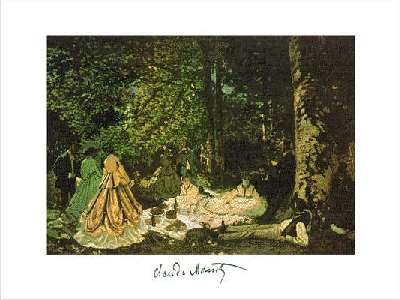
Le
Déjeuner sur l'Herbe
Luncheon
on the Grass
Claude MONET 1865
Pushkin Museum, Moscow
He worked indoors from studies he made from life.
His friends painters Bazille and Lambron are the male models, Camille Doncieux appears for the first time.
"I'm thinking all the time about my painting, and if I knew I were about to miss it, I think I would turn crazy."
Claude Monet
En 1867-68, Claude Monet réalise de nombreuses marines aux alentours du Havre et particulièrement à Sainte-Adresse. Ici, le ciel rappelle l'influence d'Eugène Boudin dans la formation du peintre.
"Si je suis devenu peintre, c'est à Eugène Boudin que je le dois."
Claude Monet
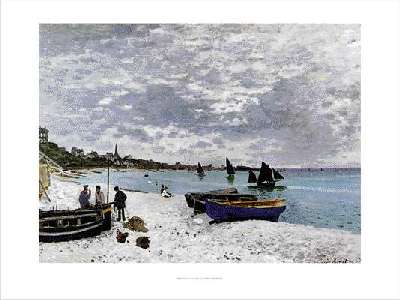
La
plage de Sainte-Adresse, temps gris
The
Beach at Sainte Adresse
Claude MONET 1867
The Art Institute of Chicago, Illinois
In 1867-68, Claude Monet made a lot of marinas around the harbour of Le Havre especially at Sainte-Adresse beach.
In this one the way Claude MONET painted the sky reminds of the influence Eugène Boudin had in his first years.
A cette époque Monet qui a épousé Camille et vit à Paris revient souvent au Havre près de sa famille. Il commence à être connu et se met ainsi à l'abri des critiques parisiens qui entretiennent sa rivalité avec Manet.
"Plus je vais plus je regrette le peu que je sais. C'est cela qui me gêne le plus, c'est certain."
Claude Monet

Terrasse
à Sainte-Adresse
Garden
at Sainte Adresse
Claude MONET 1867
Metropolitan Museum of Art, New York
At that time Monet had married Camille, lived in Paris and often came back to his parents in Le Havre. He began to be famous and took this opportunity to keep away and rest from Parisian criticists who exacerbated his rivalry with Manet.
"The more I go on, the more I regret what I know. It's what botheres me the most, that's sure."
Claude Monet
Claude et Camille MONET ont maintenant un fils : Jean. Lorsque l'hiver arrive
la petite famille s'installe à Etretat. Là, Claude Monet peint
la mer mais aussi la campagne de l'arrière pays normand.
"Je vais dans la campagne qui est si belle ici, que je trouve
peut-être plus agréable encore l'hiver que l'été."
Claude Monet
Claude and Camille MONET have now a child : Jean. When the winter came
they moved to Etretat not far from Le Havre. Claude Monet painted the seaside
but also the surrounding countryside.
"I'm going to the countryside which is so beautiful here, which is perhaps
even more pleasant in winter than in summer."
Claude Monet
Monet est rentré à Paris mais la guerre menace. Comme beaucoup de ses amis peintres il s'exile alors d'abord à Londres puis en Hollande où il fera l'acquisition de ses premières estampes japonaises. Lorsqu'ils rentrent en France Monet et les siens s'installent à Paris. En janvier 1872 ils déménagent à Argenteuil. Dès les premiers beaux jours Monet réalise ce portrait qui représente sans doute Camille.
Monet came back to Paris but the country is threatened by war. Like most artists, Claude MONET went into exile. He went first to London and then to the Netherlands where he aquired his first japanese engravings. Back to France, the Monets settled in Paris. They moved to Argenteuil (Paris suburbs) in January 1872. As soon as spring came back Claude MONET painted this portrait probably representing Camille.
Le tableau déchaina la critique et donna son nom au mouvement.
L'impressionnisme était né.

Impression,
soleil levant
Impression
Sunrise
Claude MONET 1873
Musée Marmottan, Paris
At first Monet called this painting of Le Havre at Dawn "Marina".
But as Edmond Renoir asked for a clearer title in order to put it down in the catalog of the 1874 exhibition at the photographer Nadar's, Claude MONET replied :" Then put : Impression, Sunrise".
This painting raised a storm of criticism and gave its name to the movement.
The Impressionism was born.
